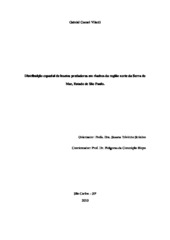| dc.contributor.author | Vilardi, Gabriel Cestari | |
| dc.date.accessioned | 2016-06-02T19:31:49Z | |
| dc.date.available | 2010-05-04 | |
| dc.date.available | 2016-06-02T19:31:49Z | |
| dc.date.issued | 2010-03-31 | |
| dc.identifier.citation | VILARDI, Gabriel Cestari. Distribuição espacial de insetos predadores em riachos
da região norte da Serra do Mar, Estado de São Paulo. 2010. 59 f. Dissertação (Mestrado em Ciências Biológicas) - Universidade Federal de São Carlos, São Carlos, 2010. | por |
| dc.identifier.uri | https://repositorio.ufscar.br/handle/ufscar/1979 | |
| dc.description.abstract | This study aimed at determining whether environmental factors as vegetation, environmental integrity, water flow, water velocity and physical and chemical characteristics of the water (pH, dissolved oxygen, temperature and conductivity) can predict the richness, abundance and faunal composition of predator insects which live in bedrock of Atlantic Rainforest streams. The collecting of fauna has been carried out in streams located in the Núcleos Santa Virgínia and Cunha-Indaiá, both located in the Parque Estadual Serra do Mar, São Paulo state, in October 2006 and October and November 2007. In each stream was selected a stretch of about 50 meters. The fauna associated with 25 cobble type rocks was collected with the aid of a hand net with a mesh of 0.25 millimeters. Were collected 779 individuals in 17 taxa. The most abundant taxa were Anacroneuria, Limnocoris, Neotrephes and Argia. The Detrended Correspondence Analysis (DCA) showed a cluster of sampling points according to the scale of the vegetation cover. The graphic representation of similarity matrix Morisita- Horn by UPGMA revealed the formation of clusters consisting of the fauna collected at sites with different water flows, but with similar vegetation cover. The Mantel Test showed a significant relationship of the predatory insects fauna in the vegetation cover (r = -0.189, p = 0.017 for 5000 permutations) and water velocity (p = 0.05 and r = -0.3 for 5000 permutations). The partial coefficients estimated from multiple linear regression showed that the flow has significant influence on the analyzed entomofauna. | eng |
| dc.description.sponsorship | Universidade Federal de Minas Gerais | |
| dc.format | application/pdf | por |
| dc.language | por | por |
| dc.publisher | Universidade Federal de São Carlos | por |
| dc.rights | Acesso Aberto | por |
| dc.subject | Interrelação específica de organismo e meio ambiente | por |
| dc.subject | Ação antrópica | por |
| dc.subject | Fauna de córregos | por |
| dc.subject | Macroinvertebrados aquáticos | por |
| dc.subject | Distribuição espacial | por |
| dc.subject | Anthropic action | eng |
| dc.subject | Aquatic macroinvertebrates | eng |
| dc.subject | Fauna of streams | eng |
| dc.subject | Spatial distribution | eng |
| dc.title | Distribuição espacial de insetos predadores em riachos
da região norte da Serra do Mar, Estado de São Paulo | por |
| dc.type | Dissertação | por |
| dc.contributor.advisor1 | Strixino, Susana Trivinho | |
| dc.contributor.advisor1Lattes | http://lattes.cnpq.br/1804083229761186 | por |
| dc.description.resumo | O presente trabalho objetivou verificar se os fatores ambientais como cobertura vegetal, integridade ambiental, vazão, velocidade da água e características físicas e químicas da água (pH, oxigênio dissolvido, temperatura e condutividade) podem predizer a riqueza, a abundância e a composição faunística de insetos predadores que vivem em substrato rochoso de riachos da Mata Atlântica. As coletas de fauna foram realizadas em riachos localizados nos Núcleos Santa Virgínia e Cunha-Indaiá, ambos localizados no Parque Estadual Serra do Mar, Estado de São Paulo, nos meses de outubro de 2006 e outubro e novembro de 2007. Em cada riacho, foi selecionado um trecho de aproximadamente 50 metros. A fauna associada a 25 rochas do tipo calhau foi coletada com o auxílio de um puçá com malha de 0,25 milímetros. Foram coletados 779 indivíduos distribuídos em 17 gêneros. Os táxons mais abundantes foram Anacroneuria, Limnocoris, Neotrephes e Argia. A Análise de Correspondência Destendenciada (DCA) mostrou um agrupamento dos pontos de coleta de acordo com a escala de cobertura vegetal. A representação gráfica da matriz de similaridade de Morisita-Horn, através da UPGMA, revelou a formação de agrupamentos constituídos pela fauna coletada em locais com diferentes vazões, porém com coberturas vegetais similares. O Teste de Mantel mostrou uma relação significativa da fauna de insetos predadores com a cobertura vegetal (r = -0,189; p = 0,017 para 5000 permutações) e a velocidade da água (p = 0,05, r = -0,3 para 5000 permutações). Os coeficientes parciais estimados a partir da regressão linear múltipla demonstraram que a vazão teve influência significativa sobre a entomofauna analisada | por |
| dc.publisher.country | BR | por |
| dc.publisher.initials | UFSCar | por |
| dc.publisher.program | Programa de Pós-Graduação em Ecologia e Recursos Naturais - PPGERN | por |
| dc.subject.cnpq | CIENCIAS BIOLOGICAS::ECOLOGIA | por |
| dc.contributor.authorlattes | http://lattes.cnpq.br/9911642960012466 | por |
